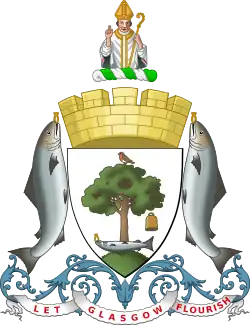List of tallest buildings and structures in Glasgow
Glasgow, the largest and most populous city in the country of Scotland, has a number of high rise buildings ranging from residential towers, offices, hotels and observation towers which stand at least 40m (131ft) in height. The current tallest structure in the city, at 127 metres (417 ft), is the Glasgow Tower, an observation tower within the Glasgow Science Centre. Its official height however incorporates the structure's spire, therefore its highest inhabitable floor is still lower than that within the 26-storey Balgrayhill tower blocks in the city's Springburn district. Prior to their demolition in 2015-2016, the Red Road and Bluevale/Whitevale tower block estates jointly held the title of Glasgow's tallest buildings, in terms of either overall height or highest inhabitable floor.
The city's Cineworld building is currently the tallest cinema building in the world.[1]
History of Glasgow skyline
Pre-war
The first tall building to have been constructed in Glasgow, and considered Scotland's first skyscraper, was the 91 m (299 ft) tall Tait Tower in Bellahouston, built for the Empire Exhibition of 1938, but was later demolished the following year.[2]
Post-war: 1954-2000
The origin of Glasgow's high rise building "boom" of the 1960s and 1970s began with the publication of the Bruce Report in 1945, which was a set of proposals to address the city's chronic overcrowding and inner city decay through a comprehensive redevelopment of the city's inner area. The city's infamous slum districts would be knocked down, and their populations dispersed out to new housing estates located on the city's periphery. The city centre would also be completely rebuilt to a new design (on Modernist principles), but most of the report's ideas were rejected. The 10-storey Moss Heights in the city's Cardonald district were completed in 1954, and were effectively the first social housing tower blocks to be constructed in the city.

By the 1960s, Glasgow Corporation had identified a series of Comprehensive Development Areas (CDAs), where overcrowding and life-expired housing was at its most serious. In the end, 29 CDAs were created, the most infamous being the Gorbals, which the Corporation used as a "test bed" for various multi-storey housing developments in tower blocks at the turn of the 1960s. All of its tenement slums were destroyed, and replaced by high-rise schemes designed by prominent architects of the period such as Basil Spence and Robert Matthew. The initial success of the Gorbals schemes then led onto the mass construction of other clusters of high rise tower blocks in various sites around the city, making Glasgow the first truly high rise city in Britain. Some of these "schemes" were planned suburbs, created from scratch - such as Red Road. Although the radical ideas for the city centre contained in the Bruce Report were not carried through, its influence was felt through the construction of a cluster of high rise office and educational buildings in the city centre during the early 1960s, such as St Andrew House, the Met Tower and the Livingstone Tower.
During the 1970s, Glasgow was considered to be the tallest city in Europe as a result of its number of high rise buildings, particularly tower blocks. During this period, it was known as the "high rise capital of Europe".[3] In 1977, the Corporation (or Glasgow District Council as it was now known) completed what would be the last social housing high-rise tower block at 22 Dundasvale Court in the Cowcaddens district.
It would not be until 1988 that high-rises were built in the city once again, with the construction of the 17-storey Forum Hotel (latterly the Moat House International Hotel, and now the Crowne Plaza Hotel) next to the SECC. The 20-storey Hilton Hotel in Anderston followed in 1992. From the early 1990s, Glasgow City Council and its successor, the Glasgow Housing Association, have run a programme of demolishing the worst of the residential tower blocks, including Basil Spence's Hutchesontown C blocks in 1993.[4]
2001–present
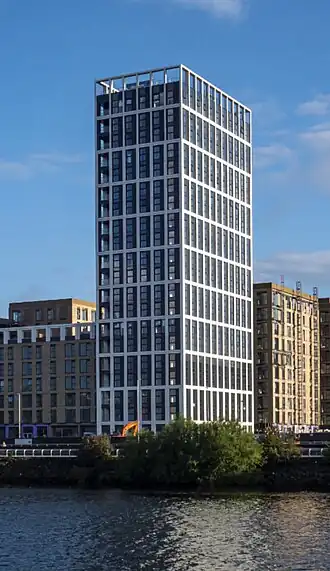
It was not until the opening of the Glasgow Tower (127 m (417 ft))[5] in 2001 that a structure surpassed the height of both the Red Road and Bluevale and Whitevale Towers. Glasgow Tower was considered a world first, mostly because of its "very innovative engineering structure that represents some of the best principles and applications of large-scale engineering design and construction".[6] During build design and construction, a complex would typically have one or more prototypes created to "prove the design before constructing a production model".[6] Given the scope of Glasgow Tower structure, this was deemed impossible and unachievable. As a result, the concept which had been created by designers "had to be proven in place" once the structure had been complete.[6] With the untested design, the Glasgow Tower initially had a number of issues following its completion, ranging from the lift to the observation deck getting stuck, as well as "strain on the thrust bearing".[6] The original thrust bearing which had been used during the construction of the tower was found to be incompatible with the structure and was ultimately replaced. The tower is jacked up annually by "up to half a metre" using a total of four hydraulic jacks, allowing the bearing to "be inspected or removed if required". During the annual maintenance routine, the bearing of the tower also "receives a synthetic grease treatment which is injected under high pressure and works its way along the grease channels on the bearing" which is considered vital to ensure the tower continues to turn smoothly.[6]
In September 2001, the worlds tallest cinema building, Cineworld Glasgow, opened and stands at 62 m (203 ft).[7][8][9] Other notable skyscrapers to be constructed across Glasgow during the 2000s decade include the 62m (203 ft) Argyle Building, and the Bridle Works Building. Recent developments during the 2010s and 2020s include the 58m tall Central Quay and Buchanan Wharf at 54m. The Ard was formally approved by Glasgow City Council in August 2024. The 36 storey, 114m tower will become the tallest habitable building in both Glasgow and Scotland upon completion.[10]
In August 2024, construction began on City Wharf, a 28–storey 87m (285 ft) skyscraper began in the Anderston Quay area of the city. Plans were submitted to Glasgow City Council in April 2023 for "almost 1,000 homes" to be constructed on a "landmark location".[11] The developer, Dandara Living, said that following "a series of public consultations", the company believed that their "application offers a terrific opportunity to create a development that reflects its unique and highly visible location".[11] In May 2023, Dandara Living altered the existing plans submitted to Glasgow City Council in order to seek planning permission to erect a memorial to commemorate the Cheapside Street whisky bond fire on 28 March 1960, a fire which cost 19 people their lives and is considered "to be the worst post-war fire services disaster".[12] Upon its completion, it will become the second tallest building in Glasgow, surpassing the University of Glasgow Tower which stands at 85m (279 ft).[13]
Recent developments
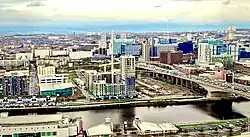
Since the late 1990s, property developers have been planning new upmarket residential and office high-rises along the River Clyde, and in the city's financial district, which would far surpass existing buildings in height. Several proposed skyscrapers, such as Elphinstone Place which would have become the tallest in the city and in Scotland, were cancelled for financial reasons.
In 2024, Glasgow City Council carried out its first ever detailed consultation on its future high-rise building policy,[14][15] publishing a "Tall Building Design Guide" in May 2025. The report still did not formally establish a definite height restriction, but merely established the areas where high rise construction in the city centre would be "least favourable" or "most favourable", and therefore most likely to be approved. The report highlighted a number of key areas:[16]
- A formal definition of "tall", depending on the overall context of surrounding buildings. Three separate scales, known as 'Local', 'District' and 'Metropolitan' are defined:
- Local: A building 2 times the height of the broader context (other structures within a 150m radius)
- District: A building 2-3.5 times the height of the broader context (other structures within a 400m radius)
- Metropolitan: A building 3.5 times or greater the height of the broader context (structures that can be seen city-wide from key vantage points such as the Campsie Fells or Cathkin Braes, in addition to the 400m context of "District" buildings)
- Within the existing Glasgow Central Conservation Area (GCCA), where the tallest structures are predominantly the spires and steeples of Victorian/Edwardian churches, permitted high rise development would be defined as "least favourable".
- Five clusters were identified where high rise construction (on the "Metropolitan" scale (above) would be "most favourable", these being Anderston/Charing Cross to the west, Cowcaddens to the north, Tradeston to the south, and Trongate along with the eastern side of High Street (bordering with the Ladywell/Dennistoun districts) to the east. These areas correlate approximately to where legacy high rise construction from the 1960s and beyond had already taken place.
Notable "tall" buildings in Glasgow
The term "tallest building in Glasgow" is itself ambiguous. Multiple structures in the city have made a claim for the title depending on which measurement is used:
- The Glasgow Tower as part of the Glasgow Science Centre on Prince's Dock on the South Bank of the River Clyde, holds the overall title as the tallest free-standing structure in Glasgow, and the whole of Scotland at a height of 127 m (417 ft), however this measurement includes the structure's spire. It holds a Guinness World Record for being the tallest tower in the world in which the whole structure is capable of rotating 360 degrees.[17]
- From 1968 until their demolition in 2015, the Red Road Flats boasted the highest inhabitable floors of any building in the city, and were the tallest residential buildings in Europe upon their completion.[18]
- The Bluevale/Whitevale twin towers stood at 91m high, making them the tallest buildings in the city prior to their demolition in 2016. Despite having one less floor than the Red Road flats, (29 inhabitable floors compared to Red Road's 30) the structures stood two metres higher than their competitors.
- Four buildings in Springburn - the two western tower blocks of the 26-storey Balgrayhill high-rise estate, and the two tower blocks at Croftbank Street - stand as the current tallest buildings in the city at 78m. Until their demolition in 2025, the four 26-storey tower blocks of the Wyndford estate in Maryhill shared the title, also standing at 78m.
- The Ard was approved by Glasgow City Council in August 2024. With 36 storeys, and standing at 114m (374ft), the building will become the tallest habitable building in both Glasgow and Scotland upon completion.[19]
Tallest completed buildings skyscrapers and structures
Tallest buildings
| Rank | Name | Image | Height | Coordinates | Floors | Year | Primary use | Location and notes |
|---|---|---|---|---|---|---|---|---|
| 1 | Glasgow Tower |  |
127 m (417 ft) | 55°51′33″N 4°17′46″W / 55.859248°N 4.296229°W | 2 | 2001 | Observation tower | Holds a Guinness World Record as the tallest tower in the world in which the whole structure can rotate 360 degrees.[20][21][22] |
| 2 | Glasgow University Tower |  |
85 m (279 ft) | 55°52′17″N 4°17′19″W / 55.871348°N 4.288641°W | ? | 1887 | University | [23][21] |
| 3= | 22 Viewpoint Place |  |
78 m (256 ft) | 55°53′28″N 4°13′48″W / 55.891233°N 4.229900°W | 26 | 1964 | Residential | Located in Springburn.[24][21][22] |
| 42 Viewpoint Place | 78 m (256 ft) | 55°53′28″N 4°13′48″W / 55.891233°N 4.229900°W | 26 | 1964 | Residential | Located in Springburn.[24][21][22] | ||
| 15 Croftbank Street |  |
78 m (256 ft) | 55°53′00″N 4°13′28″W / 55.883351°N 4.224550°W | 26 | 1964 | Residential | Located in Springburn.[24][21][22] | |
| 250 Edgefauld Road | 78 m (256 ft) | 55°53′00″N 4°13′28″W / 55.883351°N 4.224550°W | 26 | 1964 | Residential | Located in Springburn.[24][21][22] | ||
| 7= | 2 Taylor Place |  |
75 m (246 ft) | 55°51′54″N 4°14′39″W / 55.864951°N 4.244064°W | 25 | 1967 | Residential | Located in Townhead.[25][21][22] |
| 15 Grafton Place |  |
75 m (246 ft) | 55°51′54″N 4°14′39″W / 55.864951°N 4.244064°W | 25 | 1967 | Residential | Located in Townhead.[25][21][22] | |
| 12 Dobbie's Loan Place[25][21] | .jpg) |
75 m (246 ft) | 55°51′54″N 4°14′39″W / 55.864951°N 4.244064°W | 25 | 1967 | Residential | Located in Townhead.[25][21][22] | |
| 7 St. Mungo Place[25][21] |  |
75 m (246 ft) | 55°51′54″N 4°14′39″W / 55.864951°N 4.244064°W | 25 | 1967 | Residential | Located in Townhead.[25][21][22] | |
| 178 Balgrayhill Road |  |
75 m (246 ft) | 55°53′28″N 4°13′48″W / 55.891233°N 4.229900°W | 25 | 1964 | Residential | Highest man-made point above sea level within Glasgow city boundary. Located in Springburn.[24][21][22] | |
| 198 Balgrayhill Road | 75 m (246 ft) | 55°53′28″N 4°13′48″W / 55.891233°N 4.229900°W | 25 | 1964 | Residential | Highest man-made point above sea level within Glasgow city boundary. Located in Springburn.[24][21][22] | ||
| 13 | Glasgow City Chambers |  |
73 m (240 ft) | 55°51′39″N 4°14′55″W / 55.860957°N 4.248511°W | 4 | 1889 | Government Building | [26][21][22] |
| 14 | St. Andrew House | .jpg) |
71 m (233 ft) | 55°51′52″N 4°15′15″W / 55.864571°N 4.254194°W | 18 | 1964 | Hotel | Converted to a Premier Inn hotel in 2012. The rooms on the 18th floor are the highest hotel rooms in the city.[27][21] |
| 15 | Hilton Glasgow | 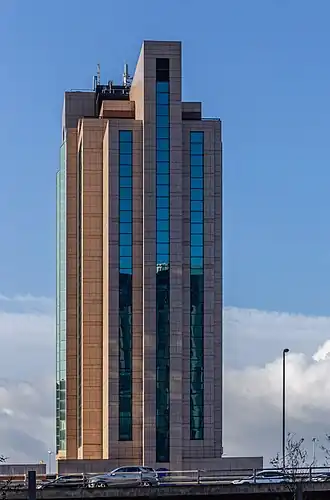 |
70 m (230 ft) | 55°51′41″N 4°16′10″W / 55.861378°N 4.269345°W | 20 | 1992 | Hotel | [28][21][22] |
| 16= | *5 tower blocks at Knightswood (Kirkton Avenue) *3 tower blocks at Cowcaddens *1 modern apartment block at Glasgow Harbour |
69 m (226 ft) | 22–24 | Various | Residential | [29][21][22] | ||
| 26= | Anniesland Court |  |
66 m (217 ft) | 55°53′28″N 4°19′31″W / 55.891020°N 4.325166°W | 24 | 1968 | Residential | Tallest listed residential building in Scotland. Only tower block to have a Category A listing in Glasgow. Located in Anniesland.[30][31][22] |
| *4 tower blocks at Sandyhills *3 tower blocks at Woodside *3 tower blocks at Kennishead |
66 m (217 ft) | 23 | Various | Residential | [22] | |||
| 37= | *2 tower blocks at Dumbreck *2 tower blocks at Pollokshaws *1 tower block at Ibrox *1 tower block at Drumchapel |
63 m (207 ft) | 22 | Various | Residential | [22] | ||
| 43= | Cineworld Glasgow | 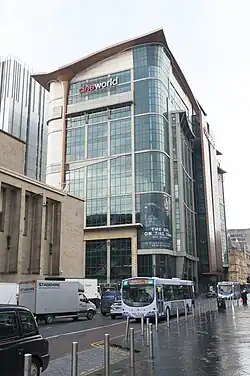 |
62 m (203 ft) | 55°51′54″N 4°15′18″W / 55.865115°N 4.254955°W | 16 | 2001 | Cinema | Tallest cinema complex in the world.[32][22] |
| Argyle Building | .jpg) |
62 m (203 ft) | 55°51′34″N 4°16′04″W / 55.859477°N 4.267824°W | 20 | 2008 | Residential | [33][22] | |
| Bridle Works Building |  |
62 m (203 ft) | 55°51′47″N 4°15′06″W / 55.862945°N 4.251771°W | 20 | 2021 | Student accommodation | ||
| 46= | *3 tower blocks at Maryhill (Glenavon Road) *1 tower block at Whiteinch |
61 m (200 ft) | 21 | Various | Residential | [22] | ||
| 50 | Queen Elizabeth University Hospital | .jpg) |
60 m (200 ft) | 55°51′43″N 4°20′28″W / 55.861973°N 4.341239°W | 14 | 2015 | Hospital | [34] |
Other notable tall structures
Buildings with a Wikipedia article and over 50 metres in height.
Tallest under construction, approved, and proposed
Under construction
| Name | Height metres / ft |
Floors | Year (est.) | Primary Use | Location | Notes |
|---|---|---|---|---|---|---|
| The Ard | 114 m (374 ft) | 36 | 2026–27 | Student Accommodation | India Street | |
| 2 Central Quay | 63 m (207 ft) | 21 | 2027 | Mixed Use | Anderston Quay |
Approved
| Name | Height metres / ft |
Floors | Year (est.) | Primary Use | Location | Notes |
|---|---|---|---|---|---|---|
| City Wharf | 87 m (285 ft) | 28 | 2026 | Residential | Anderston Quay | Approved |
| 138 Hydepark Street | 87 m (285 ft) | 26 | 2027 | Student Accommodation | Anderston Quay | Approved |
On hold
| Name | Height metres / ft |
Floors | Year (est.) | Primary Use | Location | Notes |
|---|---|---|---|---|---|---|
| The Grid | 58m (190ft) | 12 | 2020 | Office | International Financial Services District | On Hold |
Proposed
| Building Name | Height | Floors | Main Usage | Other Usage |
|---|---|---|---|---|
| Charing Cross Gateway | 86 m (282 ft) | 26 | Mixed use | |
| Custom House Quay[46] | 69 m (226 ft) | 25 | Hotel | Residential |
| Sky Plaza | 49 m (161 ft) | 16 | Residential | None |
| 10–16 Dixon Street[47] | 44 m (144 ft) | 14 | Residential | Retail |
| Homes for the Future phase 2 | 44 m (144 ft) | 13 | Residential | None |
| Central Quay Phase 5 | 42 m (138 ft) | 10 | Office | Retail |
| 145 St Vincent Street | 42 m (138 ft) | 10 | Office | None |
| Building 3 Atlantic Quay | 35 m (115 ft) | 10 | Office | None |
| St Andrews Wharf Residential | 34 m (112 ft) | 11 | Residential | None |
Unbuilt
| Name | Height | Floors | Year | Notes |
|---|---|---|---|---|
| East One | 180 m (590 ft) | 55 | The tower would have consisted of 196 residential flats, leisure, commercial space and a 96 bed hotel over a space of 12 floors, 100 flat perimeter block and 2 levels of underground parking incorporating 420 spaces.[48] | |
| Cheapside Tower 1 | 170 m (560 ft) | 50 | A development comprising three towers: 1, 2 and 3. Each tower would have had accommodation over 50 floors.[49] | |
| Cheapside Tower 2 | 170 m (560 ft) | 50 | ||
| Cheapside Tower 3 | 136 m (446 ft) | 50 | ||
| Elphinstone Place | 134 m (440 ft) | 39 | Cancelled due to the 2008 Financial crisis. Now the site of the new Scottish Power HQ.[50] | |
| Elmbank Tower | 107.5 m (353 ft) | 28 | [51] | |
| Glasgow Harbour Tower | 93 m (305 ft) | 30 | ||
| Elphinstone Urban Village Tower 1 | 81 m (266 ft) | 27 | ||
| Graving Docks Tower 1 | 65 m (213 ft) | 21 | ||
| Elphinstone Urban Village Tower 2 | 60 m (200 ft) | 20 |
Demolished
| Name | Image | Height | Coordinates | Floors | Year built | Year demolished | Notes |
|---|---|---|---|---|---|---|---|
| Townsend Chimney | 138 m (453 ft) | 55°52′16″N 4°15′05″W / 55.8712°N 4.2514°W | N/A | 1859 | 1928 | At J. Townsend Chemical Works, Port Dundas. Tallest chimney in the world from 1859 to 1889.[52][53][54][55][56] | |
| Tennant's Stalk | 133 m (436 ft) | 55°52′13″N 4°14′05″W / 55.8702°N 4.2346°W | N/A | 1842 | 1922 | At the St Rollox Chemical Works, Springburn. Tallest chimney in the world from 1842 to 1859. Demolished after being struck by lightning.[52][53][57][58][56] | |
| Pinkston Power Station cooling tower | 94 m (308 ft) | 55°52′20″N 4°14′50″W / 55.8723°N 4.2472°W | 1952 | 1976 | Largest cooling tower in Europe at time of completion. Complex in Port Dundas (providing energy for the Glasgow Corporation Tramways) also included two 263 ft (80 m) chimney stacks.[59][60][61] | ||
| Tait Tower | 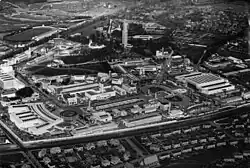 |
91.4 m (300 ft) | 55°50′44″N 4°19′05″W / 55.8455°N 4.3181°W | ? | 1938 | 1939 | Built as part of the 1938 Empire Exhibition. |
| Bluevale and Whitevale Towers (2) | 90.8 m (298 ft) | 55°51′21″N 4°12′56″W / 55.8559°N 4.2155°W | 30 | 1968 | 2015 | 109 Bluevale Street and 51 Whitevale Street. Tallest inhabitable buildings in Scotland from time of completion to time of demolition. Located in Gallowgate.[62] | |
| Red Road Flats (6 - 'point' blocks) |
 |
89 m (292 ft) | 55°52′49″N 4°12′30″W / 55.8803°N 4.2082°W | 31 | 1967 | 2015[E] | 21 Birnie Court, 33 Petershill Drive, 63 Petershill Drive, 93 Petershill Drive, 123 Petershill Drive and 10 Red Road Court. Tallest residential buildings in Europe at the time of completion.[63] Located in Balornock / Barmulloch. |
| Wyndford Road towers (4) | .jpg) |
78 m (256 ft) | 55°53′15″N 4°17′44″W / 55.8874°N 4.2955°W | 26 | 1964 | 2025[64] | 120 Wyndford Road, 151 Wyndford Road, 171 Wyndford Road, 191 Wyndford Road. Located in Wyndford (Maryhill).[65][21] |
| Red Road Flats (2 - 'slab' blocks) |
 |
78 m (256 ft) | 55°52′48″N 4°12′24″W / 55.8800°N 4.2068°W | 28 | 1967 | 2015[F] | 10-30 Petershill Court, 153-213 Petershill Court.[63] |
| Clydesdale Bank Tower |  |
73 m (240 ft) | 55°51′32″N 4°17′42″W / 55.8589°N 4.2951°W | 1 | 1987 | 1989 | Built for the Glasgow Garden Festival, later moved to Rhyl in Wales.[66] |
| Roystonhill towers (3) | _(cropped).jpg) |
72 m (236 ft) | 55°52′03″N 4°13′26″W / 55.8676°N 4.2239°W | 25 | 1967 | 2016[G] | 240 Roystonhill, 20 Rosemount Street, 40 Rosemount Street. Located in Royston.[67] |
| Gorbals towers (10) |  |
69 m (226 ft) | 24 | Various | Various | Four slab blocks at Laurieston (Norfolk Court), two blocks at Sandiefield Road, four blocks at Hutchesontown (Caledonia Road). Located in the Gorbals.[22] |
See also
- Glasgow tower blocks
- List of tallest buildings and structures in Edinburgh
- List of tallest buildings and structures in Scotland
Notes
References
- ^ "The world's tallest cinema built on a historic Glasgow entertainment patch". Glasgow Times. 28 August 2022. Archived from the original on 23 August 2024. Retrieved 23 August 2024.
- ^ "BBC Scotland - BBC Scotland - Why Scotland's first skyscraper – built for the 1938 Empire Exhibition – was (unexpectedly?) demolished just one year later". BBC. Archived from the original on 22 February 2025. Retrieved 23 April 2025.
- ^ "High-rise and fall – Glasgow's tower block history". City Live. 27 October 2022. Retrieved 23 April 2025.
- ^ McLean, David (16 April 2022). "The notoriously dire Gorbals flats that locals dubbed 'The Dampies'". Glasgow Live. Retrieved 3 August 2023.
- ^ "The troubled history of the rotating Glasgow Tower". BBC News. 31 March 2024. Archived from the original on 19 April 2025. Retrieved 23 April 2025.
- ^ a b c d e "Getting curious about Glasgow Tower | Glasgow Science Centre". www.glasgowsciencecentre.org. Retrieved 18 August 2025.
- ^ Roland, Denise (20 November 2016). "Cineworld and its founder: nine things you did not know". The Daily Telegraph. Retrieved 22 August 2016.
- ^ "Cineworld Cinema Renfrew St". Gallivant in Glasgow – The ultimate Glasgow guide, by Glasgows people. Glasgowvant Attractions. Archived from the original on 4 September 2011. Retrieved 22 August 2016.
- ^ "Glasgow Cinemas Information". Information on cinemas in glasgow. Retrieved 22 August 2016.
- ^ "Go-ahead for 36-floor student tower in Glasgow". BBC News. 20 August 2024. Retrieved 23 August 2024.
- ^ a b Loudon, Calum (25 April 2023). "Plans unveiled to build almost 1,000 homes in 'landmark' city location". STV News. Retrieved 24 April 2025.
- ^ Sandelands, Drew (15 May 2023). "Glasgow plan to build 1,000 homes could include fire disaster memorial". Glasgow Live. Retrieved 24 April 2025.
- ^ "The Gilbert Scott Building". University of Glasgow. Retrieved 17 January 2019.
- ^ Flatman, Ben (20 August 2024). "Glasgow launches public consultation on tall buildings policy". Building.
- ^ "Consultation on Tall Buildings in Glasgow begins". Glasgow City Council. Glasgow City Council. 12 August 2024.
- ^ Spocchia, Gino (9 June 2025). "Glasgow agrees tall-buildings policy". Architect's Journal. EMAP Publishing Ltd.
- ^ Williams, Craig (9 June 2023). "Glasgow Tower: 'White elephant' reopens after four-year hiatus". The Herald. Archived from the original on 3 August 2023. Retrieved 3 August 2023.
- ^ "Red Road Flats: A social history of Glasgow's most controversial towers". Glasgow World. Retrieved 23 August 2024.
- ^ "Go-ahead for 36-floor student tower in Glasgow". BBC News. 20 August 2024. Archived from the original on 12 March 2025. Retrieved 23 August 2024.
- ^ "Science Centre Tower". Emporis. Archived from the original on 4 December 2019.
- ^ a b c d e f g h i j k l m n o p q r s t David McLean (4 May 2017). "Glasgow's top 15 tallest buildings". The Scotsman. Retrieved 17 January 2019.
- ^ a b c d e f g h i j k l m n o p q r s t u v w x y z aa 100 results found [Glasgow: Building search], SKYDB. Retrieved 9 August 2025
- ^ "The Gilbert Scott Building". University of Glasgow. Archived from the original on 19 January 2019. Retrieved 17 January 2019.
- ^ a b c d e f "Buildings in Glasgow: Springburn". Emporis. Archived from the original on 19 January 2019. Retrieved 27 February 2019.
- ^ a b c d e f "Buildings in Glasgow: Townhead". Emporis. Archived from the original on 19 January 2019. Retrieved 27 February 2019.
- ^ "Glasgow City Chambers". Emporis. Archived from the original on 4 December 2019.
- ^ "St. Andrew's House". Emporis. Archived from the original on 4 December 2019.
- ^ "Glasgow International Hilton Hotel". Emporis. Archived from the original on 4 December 2019.
- ^ "Buildings in Glasgow: Page 2". Emporis. Archived from the original on 17 May 2016. Retrieved 27 February 2019.
- ^ "Tower Block UK: Anniesland Cross". University of Edinburgh. Archived from the original on 19 January 2019. Retrieved 13 January 2019.
- ^ "Anniesland Court". Emporis. Archived from the original on 4 December 2019.
- ^ "Glasgow UGC Multiplex". Emporis. Archived from the original on 4 December 2019.
- ^ "Cadogan Square". Emporis. Archived from the original on 4 December 2019.
- ^ "Glasgow South Adult Hospital". Emporis. Archived from the original on 27 August 2019.
- ^ Vivienne Nicoll (23 May 2013). "£5m city turbine will be visible around world". Evening Times. Retrieved 24 January 2019.
- ^ "Glasgow Cathedral". Emporis. Archived from the original on 4 December 2019.
- ^ "Renfield St. Stephen's Church". Emporis. Archived from the original on 6 September 2019.
- ^ Lansdowne Parish Church, Glasgow, Scotland's Churches Trust
- ^ "Highland Cathedral". Emporis. Archived from the original on 4 December 2019.
- ^ "St. Mary's Episcopal Cathedral". Emporis. Archived from the original on 4 December 2019.
- ^ Dowanhill UP Church, Dictionary of Scottish Architects via Historic Environment Scotland
- ^ "Crowne Plaza Hotel". Emporis. Archived from the original on 4 December 2019.
- ^ "Finnieston Crane". Clyde Waterfront. Archived from the original on 26 April 2014. Retrieved 17 January 2019.
- ^ "Premier Inn Glasgow Charing Cross". Emporis. Archived from the original on 4 December 2019.
- ^ "Livingstone Tower, University of Strathclyde". Emporis. Archived from the original on 4 December 2019.
- ^ "Custom House Quay". Emporis. Archived from the original on 4 December 2019.
- ^ "Dixon Street Development". Emporis. Archived from the original on 4 December 2019.
- ^ "Frame Instructions". www.futureglasgow.co.uk. Archived from the original on 30 March 2024. Retrieved 23 April 2025.
- ^ "Glasgow tower blocks, Scottish skyscrapers". design. 24 October 2010. Retrieved 23 April 2025.
- ^ "Elphinstone Place". Emporis. Archived from the original on 4 December 2019.
- ^ "Elmbank Tower". Emporis. Archived from the original on 4 December 2019.
- ^ a b Robert Bancroft; Francis Bancroft (1885). Tall Chimney Construction (PDF). Lewes: Farncombe and Co. p. 33. Retrieved 18 February 2019.
- ^ a b Lynn Pearson (2016). Victorian and Edwardian British Industrial Architecture. The Crowood Press. p. 31. ISBN 9781785001901. Archived from the original on 23 October 2023. Retrieved 18 February 2019.
- ^ "Forth & Clyde Canal, Townsend's chimney, Glasgow". Archive Images. Archived from the original on 18 February 2019. Retrieved 18 February 2019.
- ^ "Port Dundas Townsend Chimney". SkyscraperPage.
- ^ a b When Glasgow had the Tallest Chimney(s) in the World Archived 10 January 2022 at the Wayback Machine, A Hauf Stop, 20 July 2021. Retrieved 10 January 2022
- ^ "St. Rollox Chemical Works in Glasgow". BBC Sport. Alamy. Retrieved 18 February 2019.
- ^ "Tennant's Stalk". SkyscraperPage.
- ^ "Glasgow, North Canal Bank Street, Pinkston Power Station". Canmore. Archived from the original on 10 April 2021. Retrieved 28 February 2019.
- ^ "Pinkston Power Station". The Glasgow Story. Archived from the original on 28 February 2019. Retrieved 28 February 2019.
- ^ Landmark vanishes in just six seconds Archived 23 October 2023 at the Wayback Machine, Glasgow Herald, 20 September 1976
- ^ "Buildings in Glasgow: Gallowgate". Emporis. Archived from the original on 19 January 2019. Retrieved 27 February 2019.
- ^ a b "Buildings in Glasgow: Red Road". Emporis. Archived from the original on 19 January 2019. Retrieved 27 February 2019.
- ^ "Glasgow tower blocks demolished by controlled explosions". BBC News. 22 March 2025. Archived from the original on 24 March 2025. Retrieved 26 March 2025.
- ^ "Buildings in Glasgow: Wyndford". Emporis. Archived from the original on 19 January 2019. Retrieved 27 February 2019.
- ^ "Clydesdale Tower". Emporis. Archived from the original on 4 December 2019.
- ^ "Buildings in Glasgow: Royston". Emporis. Archived from the original on 19 January 2019. Retrieved 27 February 2019.
.jpg)
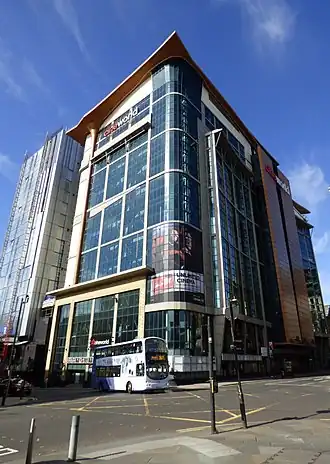

.jpg)

.jpg)
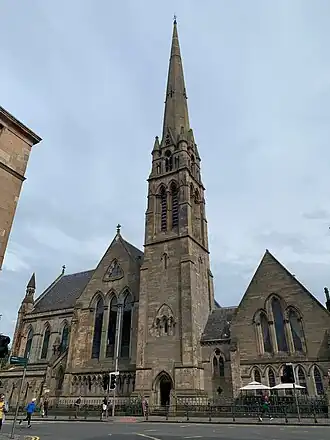

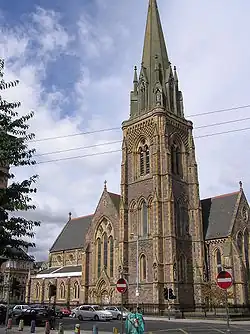
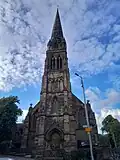
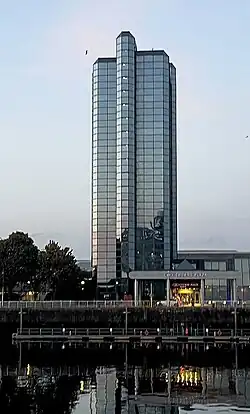
.jpg)

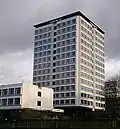
.jpg)
